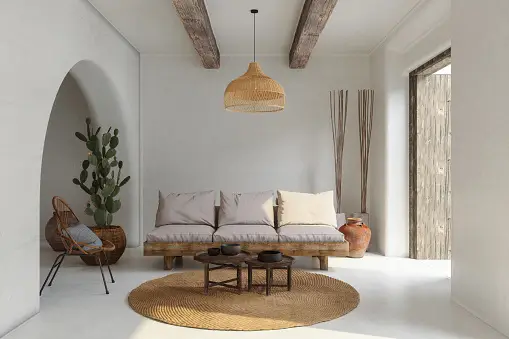Embarking on the journey of decorating a new home is both exciting and challenging. It presents an opportunity to express your personal style and create a space that truly feels like your own. This process is more than just selecting furniture or hanging pictures; it’s about crafting an environment that reflects your personality, values, and lifestyle. Whether you’re moving into your first home or transitioning to a new space, each room offers a blank canvas for your creativity and vision. The key is to approach this task with a blend of practicality and imagination. Consider functionality, comfort, and aesthetics as you envision each space. The goal is not just to fill rooms with decor, but to curate spaces that inspire and comfort you daily. This article aims to guide you through this creative process, offering tips and ideas to transform your new house into a warm, inviting, and personalized home.

Assessing Your Space and Style
Before delving into the actual decorating process, it’s vital to assess the layout and dimensions of your new home. Understanding the spatial dynamics is crucial for selecting appropriate furniture and decor. Start by measuring the rooms to ensure that any new or existing furniture fits comfortably without overcrowding the space. It’s equally important to evaluate the natural light in each room, as it will influence the colors and textures that will work best.
In parallel with spatial assessment, consider your personal style. Are you inclined towards modern minimalism, cozy country, or eclectic boho? Identifying your style preference will guide your decor choices, ensuring a cohesive look throughout the home. This phase of planning is also the perfect time to consult professionals like Safebound moving and storage, who can offer valuable advice on transporting and arranging furniture to maximize space and aesthetics.
Their expertise can help in efficiently organizing your belongings, making the decoration process smoother and more enjoyable. Remember, the ultimate goal is to create a harmonious balance between your personal style and the functional layout of your new home, making it a true reflection of your personality and lifestyle.
Color Scheme Selection Tips
Choosing the right color scheme is a cornerstone of home decorating. It sets the mood and tone for each room, influencing how the space is perceived and enjoyed. Before deciding on colors, it’s essential to consider the function of each room and the emotions you want to evoke. For instance, calming hues may be ideal for bedrooms, while vibrant colors can energize a living space.
To get started, here are some key points to consider:
- Start with a Neutral Base: Neutral colors like beige, gray, or white offer flexibility and longevity.
- Add Layers with Accent Colors: Introduce bold or contrasting colors through accessories and textiles.
- Consider Color Psychology: Different colors can evoke various emotions and moods.
- Use Natural Light as a Guide: Observe how colors change in different lighting conditions.
- Draw Inspiration from Art or Rugs: These can be great starting points for your color palette.
For more detailed guidance, resources like the American Society of Interior Designers can help you understand color theory and combinations. When selecting colors, it’s not just about personal preference but also about creating a harmonious balance that enhances the overall ambiance of your home.
Experimenting with swatches and samples in your actual space is also a practical approach. This way, you can see how the colors interact with your furniture, lighting, and the natural character of each room. Remember, the right color scheme can transform a space, making it a true embodiment of your style and vision.
Maximizing Small Spaces Creatively
Decorating a smaller space presents unique challenges, but with a bit of creativity, these areas can become cozy, functional, and stylish. The key to maximizing small spaces lies in choosing the right furniture and layout to create an illusion of more room. Opt for multi-functional furniture, like a sofa bed or a coffee table with storage, to reduce clutter and enhance practicality. Mirrors are also a fantastic way to create a sense of spaciousness; strategically placing mirrors can reflect light and visually expand the room.
Another effective strategy is to use light colors on walls and floors, as they make spaces feel airier and more open. However, don’t shy away from adding a few bold elements to give the room character – a statement piece of art or a colorful cushion can add a touch of vibrancy without overwhelming the space. Vertical space is often underutilized, so consider wall-mounted shelves or tall, narrow furniture pieces to make the most of the height of the room.
Remember, the objective is not just to fit everything in, but to create a space that feels inviting and comfortable. With thoughtful planning and design choices, even the smallest spaces can be transformed into charming and efficient areas that reflect your personal style and meet your daily needs.
DIY Decor Projects for Personalization
Adding a personal touch to your home decor can be both fulfilling and fun, especially through DIY projects. These activities not only allow for a personalized space but also offer a sense of accomplishment. Before starting, it’s important to identify projects that
match your skill level and the time you can commit.
Here are a few ideas to consider:
- Hand-Painted Wall Art: Create your own artwork that reflects your style.
- Upcycled Furniture: Transform old pieces into something new and unique.
- Customized Shelving: Build shelves that fit perfectly into your space.
For more DIY home project ideas, websites like DIY Network provide a wealth of resources and step-by-step guides. These projects not only add a unique flair to your decor but also can be a fun activity to engage in. Whether it’s repainting an old chair or crafting a new picture frame, these personal touches make your house feel more like a home.
It’s about putting a piece of yourself into your living space, turning it into a reflection of your personality and creativity. Remember, the goal of DIY decor isn’t perfection; it’s about creating something that speaks to you and enhances your living environment.
Integrating Sustainable Decor Ideas
Incorporating sustainable decor in your home decoration strategy is not only an environmentally conscious choice but also adds a unique aesthetic appeal. Sustainable decor involves using materials and products that have minimal environmental impact, such as recycled items, eco-friendly fabrics, and sustainably sourced wood. Opting for energy-efficient lighting and appliances can also play a significant role in making your home more eco-friendly. Adding indoor plants can improve air quality while adding a natural, refreshing element to your decor. For those looking to further enhance their space with environmentally friendly options, exploring ideas to upgrade your space can be both inspiring and beneficial. This approach to home decoration not only contributes to a healthier planet but also creates a living space that reflects a commitment to sustainability and mindful living.
Embracing Your New Space
As you complete your decorating journey, take a moment to appreciate the transformation of your new home. The blend of colors, furniture, and personal touches all come together to create a space that truly resonates with your personality and lifestyle. This process of turning a house into a home is a rewarding experience, reflecting your unique taste and the effort you’ve invested. Remember, home decorating is an ongoing journey, evolving with your tastes and life changes.



